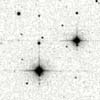
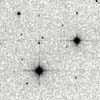
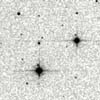
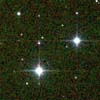
(300" x 300" subimage)
a star scanned by the 2MASS northern facility
The 2MASS All-Sky Release catalogs have been meticulously filtered of spurious sources to provide a highly reliable and complete data set. The Atlas Images, on the other hand, still contain many of the artifacts which caused these spurious detections since no attempt was made to remove these from the image data a posteriori. On this page, various classes of image anomalies are presented so that the user can gain familiarity with these oddities and recognize them when they are encountered.
i. Types of Anomalies
Bright stars cause many artifacts. Some of these, such as reflections off of the dichroic surfaces, create point-like artifacts. Others, such as diffraction spikes, are more obvious as artifacts on the images but can sometimes create their own false point and extended sources. Each of these artifacts is easily identifiable because its position and magnitude relative to the parent source are very repeatable. The well understood geometry and brightness difference allows us to flag such sources as false in the source lists. Details concerning the parameters used to flag bright star artifacts can be found in Section IV.7, though a terse summary of the geometry is given below.
Point-like anomalies near bright stars
Reflections from the filter and dichroic surfaces (also referred to as "filter glints") appear within a few arcseconds of each bright star and are marked with a green "x" on the IRSA 2MASS Quicklook Image Services. The geometry and number of glints is different between the northern and southern 2MASS cameras, so examples are shown for each hemisphere. Objects scanned from the northern telescope show three glints: a 3-band glint 1.5" W and 14.0" S of the parent, a J-only glint 3.0" W and 28.5" S of the parent, and a Ks-only glint 4.0" E and 16.5" N of the parent. Objects scanned from the southern telescope show four glints: 3-band glints at 2.5" E/11.0" N and at 1.0" W/13.5" S, and J-only glints at 6.5" E/22.0" N and at 10.0" E/33.5" N.

| 
| 
| 
|
| J | H | Ks | 3-color |
| Date 000207n, Scan 072, Image 44 (300" x 300" subimage) | |||
| Dichroic/filter reflections (glints)
immediately adjacent to Gliese 445, a star scanned by the 2MASS northern facility | |||
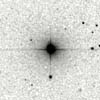
| 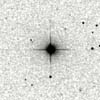
| 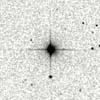
| 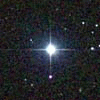
|
| J | H | Ks | 3-color |
| Date 991011s, Scan 082, Image 139 (300" x 300" subimage) | |||
| Dichroic/filter reflections (glints)
immediately adjacent to Kapteyn's Star, as scanned by the 2MASS southern facility | |||
Latent images of a bright star (also referred to as "persistence artifacts") leave a trail of point-like anomalies either to the north or south of the bright star, depending on scan direction. These artifacts, marked with a red "x" on the IRSA 2MASS Quicklook Image Services, are separated from the bright star and from each other by integral frame spacings (roughly 83") in Declination.
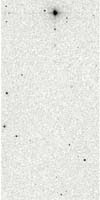
| 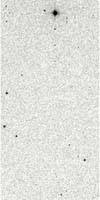
| 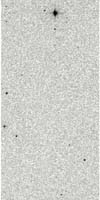
| 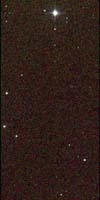
|
| J | H | Ks | 3-color |
| Date 000301s, Scan 070, Image 233 (full image) | |||
| Latent images (persistence) in a south-going
scan, in this case, trailing south from the star Wolf 359 | |||
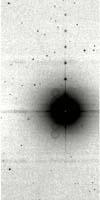
| 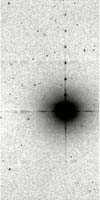
| 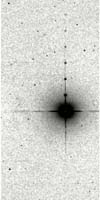
| 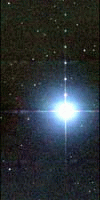
|
| J | H | Ks | 3-color |
| Date 981126s, Scan 007, Image 115 (full image) | |||
| Latent images (persistence) in a north-going
scan, in this case, trailing north from the star epsilon Eridani | |||
Other anomalies near bright stars
Diffraction spikes run radially away from the star in the four cardinal directions. Although these spikes often create false sources, on the images they are very rarely confused with real astrophysical objects. Extremely bright stars also exhibit interesting reflection artifacts that show up as wisps and rings in the star's immediate vicinity. Discontinuities at the frame edges due to background mismatches between frames may also be seen in these images and around other extremely bright objects.
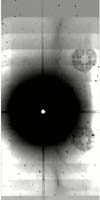
| 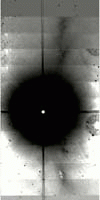
| 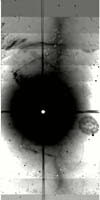
| 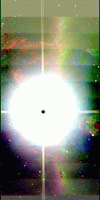
|
| J | H | Ks | 3-color |
| Date 990417s, Scan 092 ,Image 115
(full image) | |||
| Reflection artifacts and diffraction spikes in the immediate vicinity of Antares | |||
An electronic feedback associated with the quad readout of the detectors also imprints into the images around bright stars. A line of heightened charge appears at positions +/-128 lines (256") north or south of the star, and an electronic echo of the bright star sometimes also appears at positions on the chip that are +/-128 lines and/or +/-128 rows (256" in RA and/or Dec) from the star itself. These echoes can sometimes be mistaken as real point sources on the images.
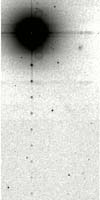
| 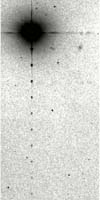
| 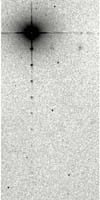
| 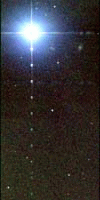
|
| J | H | Ks | 3-color |
| Date 000806s, Scan 142, Image 186
(full image) | |||
| "Line-128 stripe" artifact (horizontal line) and
"star echo", in this case seen most prominently at J, associated with the star tau Ceti | |||
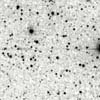
| 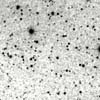
| 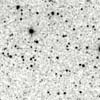
| 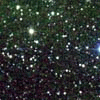
|
| J | H | Ks | 3-color |
| Date 990720s, Scan 070, Image 267 (300" x 300" subimage) | |||
| "Star echo" that, in this case, looks far more like a real source | |||
Other anomalies further away from bright stars
Other reflections can appear much further away from the very brightest stars. One set of reflections appears as a set of striped bands a few arcminutes away from the star.
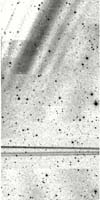
| 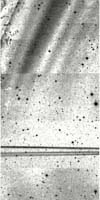
| 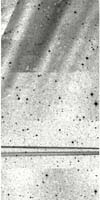
| 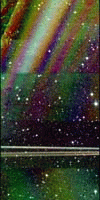
|
| J | H | Ks | 3-color |
| Date 980704s, Scan 034, Image 162
(full image) | |||
| Striped reflection artifacts roughly 25
arcminutes away from Antares (diffraction spikes also seen here) | |||
Other reflections appear as a faint haze along with short, diagonal stripes that appear degrees away, usually only at H and Ks bands. These will rarely be mistaken as true sources, however.
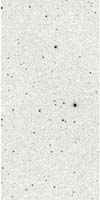
| 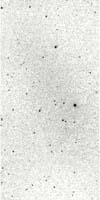
| 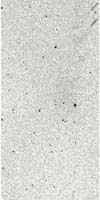
| 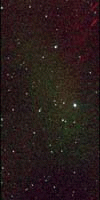
|
| J | H | Ks | 3-color |
| Date 981029s, Scan 022, Image 174
(full image) | |||
| More distant reflections
(seen here at Ks only) from R Doradus, 1.6 degrees distant | |||
In a few cases the off-axis light from very bright stars causes problems with the meteor blanking algorithms resulting in blanking of partial frames which leave strips or triangles at higher or lower background levels relative to the rest of the image. Their nature as image artifacts should be obvious.
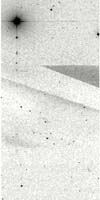
| 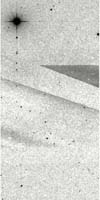
| 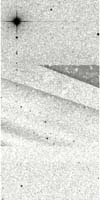
| 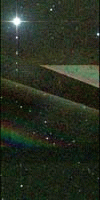
|
| J | H | Ks | 3-color |
| Date 981028s, Scan 123, Image 115
(full image) | |||
| Backgrounding problems in the vicinity of R Doradus. | |||
Vertical and horizontal diffraction spikes from the very brightest stars can also appear degrees away from the star itself.
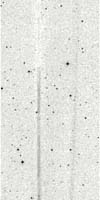
| 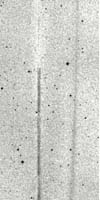
| 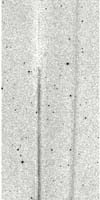
| 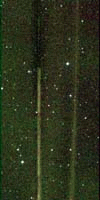
|
| J | H | Ks | 3-color |
| Date 990318n, Scan 131, Image 056
(full image) | |||
| Widely separated vertical diffraction spikes from alpha Herculis, 2.4 degrees distant | |||
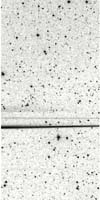
| 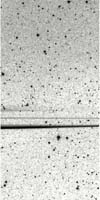
| 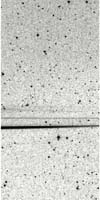
| 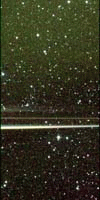
|
| J | H | Ks | 3-color |
| Date 980704s, Scan 039, Image 115
(full image) | |||
| Horizontal diffraction spikes from Antares, 1 degree distant | |||
Though many meteors and satellites were successfully cleaned from the image data, some trails or pieces of trails remain. In cases where parts of the trail were blanked and other parts remain, pieces of the residual trail may mimic true astrophysical point sources.
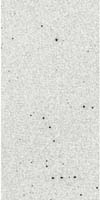
| 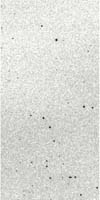
| 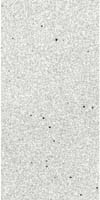
| 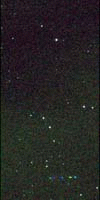
|
| J | H | Ks | 3-color |
| Date 000404s, Scan 068, Image 209
(full image) | |||
| Nearly east-west meteor/satellite streak is broken into multiple small pieces | |||
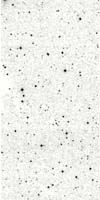
| 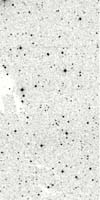
| 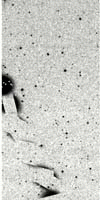
| 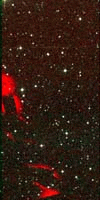
|
| J | H | Ks | 3-color |
| Date 980710n, Scan 036, Image 021
(full image) | |||
| Bug leaves very bright Ks residuals and holes across J and H Images | |||
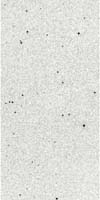
| 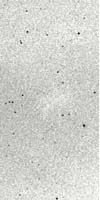
| 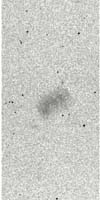
| 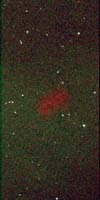
|
| J | H | Ks | 3-color |
| Date 990622n, Scan 015, Image 173
(full image) | |||
| Another bug artifact which looks much more like a real astrophysical
object, in this case, a Ks-only nebula. | |||
A bright star falling at the edge or just off the edge of the chip can throw a spray of light onto the array. Although many of these cases were cleaned by the transient source detector, some residual glints remain. The most prevalent cases are seen along the southern edge of the Ks array in the southern camera, giving rise to a Ks "hat" artifact to the north of bright stars.
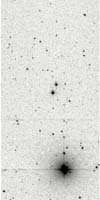
| 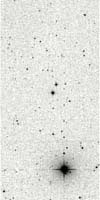
| 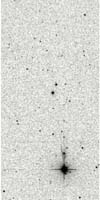
| 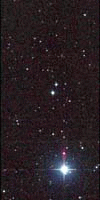
|
| J | H | Ks | 3-color |
| Date 981228s, Scan 070, Image 056
(full image) | |||
| A Ks "hat" artifact north of a bright star, a peculiarity or "feature" of the southern data | |||
Rapidly changing OH airglow emission will show up in the images as uneven overall background level. Because OH airglow is most pronounced at H-band, the uneven backgrounds will be worst at that band.
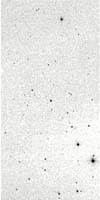
| 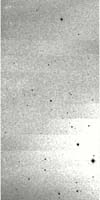
| 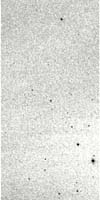
| 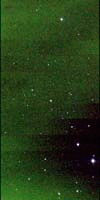
|
| J | H | Ks | 3-color |
| Date 980518s, Scan 066, Image 080
(full image) | |||
| Obvious background changes across H Image | |||
Occasionally a cosmic ray will fail to be cleaned by the transient source detector.
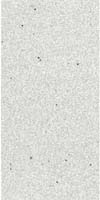
| 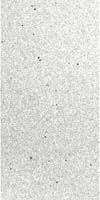
| 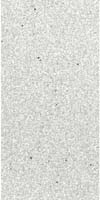
| 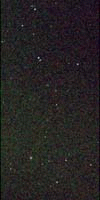
|
| J | H | Ks | 3-color |
| Date 000227s, Scan 049, Image 209
(full image) | |||
| H-only residual cosmic ray | |||
ii. Lists of Known Anomalies
Because of their potential for confusion with real sources, we have attempted to flag all instances of dichroic/filter reflections, latent (persistence) images, and trails left by meteors, satellites, or insects. Dichroic/filter reflections and persistence sources are already marked in both the catalog and on the Quicklook Images. A complete list of meteor, satellite, and insect trails can be found in Table 1. Although we have used many separate diagnostic tools to uncover such transient sources, no single diagnostic is perfect and there are too many quicklook images to examine by eye. If you, the user, should find an example of a trail not listed in the table, please drop us a note at 2mass@ipac.caltech.edu and we will add the anomaly to the list.
In the case of other, non point-like bright star artifacts, uncleaned cosmic rays, edge glints, and electronic artifacts, we have not attempted to make complete lists. Nonetheless, the lists below tabulate such known anomalies in case the user should be interested in further examples.
| TABLE 1 | |||
| Type of anomaly | Number of images affected (per band) | Code in list | List |
| ALL ANOMALIES | 485 | - | Full list |
| Satellite trails | 202 | s | List |
| Insect trails | 135 | i | List |
| Meteor trails | 89 | m | List |
| Reflections from distant bright stars | 42 | r | List |
| Background problems near bright stars | 7 | b | List |
| Cosmic rays | 6 | c | List |
| Glints from the edge of chip | 3 | g | List |
| Electronic feedback artifacts | 1 | e | List |
[Last Updated: 2003 Mar 13; Davy Kirkpatrick, Schuyler Van Dyk, Gene Kopan, Tracey Evans]